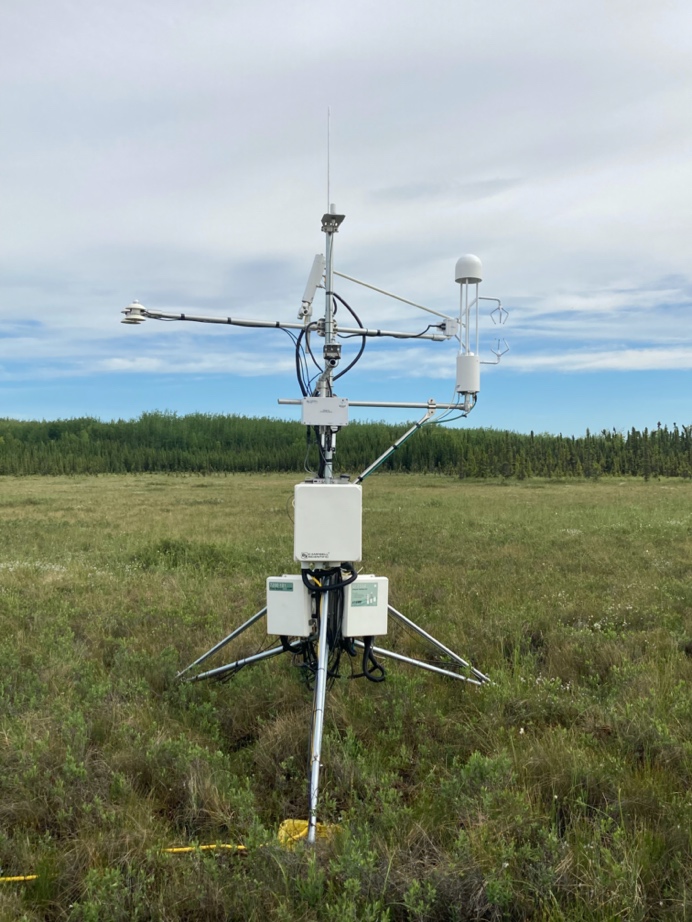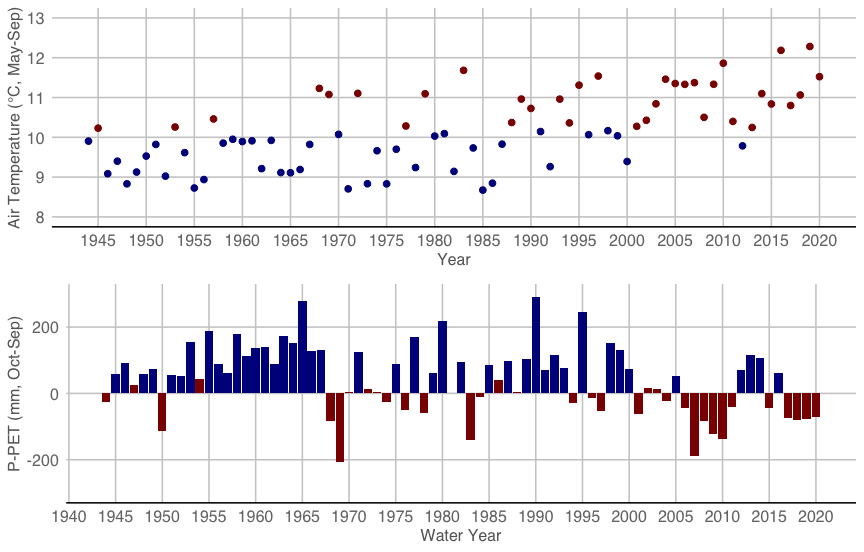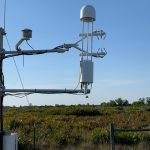Greenhouse gas flux responses to wetland drying and vegetation succession in the Kenai Lowlands, southcentral Alaska

Lily Lake Fen eddy covariance station (US-KPL) was installed during March of 2021 in a well-hydrated fen. Image credit: Patrick Sullivan, University of Alaska Anchorage.
The Science
High latitude wetlands play a critical role in the global climate system (e.g., Bridgham et al. 2006). Typically dominated by highly productive mosses and sedges, these ecosystems assimilate large quantities of atmospheric carbon dioxide (CO2). Meanwhile, their cold and wet soils restrict decomposition of dead plant material, leading to thick peat deposits which represent large stocks of carbon (C) (Clymo et al. 1998). A recent estimate indicates that subarctic and boreal wetlands contain approximately 500 gigatons of soil C (Yu 2012), an amount equivalent to 65% of atmospheric C. The role of high latitude wetlands in the global climate system is complicated by their tendency to act as strong sources of methane (CH4), which is a potent greenhouse gas that is produced during anaerobic respiration in water-inundated soils. The net greenhouse gas forcing of a wetland ecosystem must account for fluxes of both CO2 and CH4. At present, it remains uncertain whether the strong CO2 sink behavior of high latitude wetlands outweighs their tendency to also be strong sources of CH4 to the atmosphere.

Changes in climate observed over the past 76 years at the Kenai Airport. Figure credit: Patrick Sullivan, University of Alaska Anchorage
The Impact
The Kenai Lowland region of southcentral Alaska is an extensive wetland complex with very large stocks of soil C. Climate of the region has rapidly become warmer and drier over the past 50 years. Warming and drying of the Kenai Lowlands has led to invasion of moss- and sedge-dominated wetlands by woody shrubs and black spruce trees (Klein et al. 2005, Berg et al. 2009). This process of wetland drying and vegetation succession complicates estimates of greenhouse gas forcing, because a drier and woodier wetland is expected to take up more CO2 through photosynthesis (greater leaf area), lose more CO2 through soil respiration (Ives et al. 2013) and emit less CH4 with improved soil aeration.
Summary
In March of 2021, we completed the installation of an eddy covariance station in a well-hydrated fen near Lily Lake in the Kenai Lowlands. The AmeriFlux program graciously loaned us a LI-COR LI-7700 open-path CH4 to ensure that we incorporated both CO2 and CH4 fluxes in our accounting of greenhouse gas forcing of the Lily Lake fen. Preliminary data analyses indicate that the Lily Lake fen was a strong sink for atmospheric CO2 during June, July and August of 2021. Quality assured data will be uploaded to the AmeriFlux network before the end of 2021.
We are actively seeking funding to support the installation of two additional eddy covariance stations: one in a drying wetland that is being encroached by woody vegetation and one in a nascent black spruce forest atop a previously herbaceous wetland. We aim to measure both CO2 and CH4 fluxes at all three stations throughout the annual cycle for at least a decade. Expanding our site network to include three stations along a gradient of hydrologic change (well-hydrated fen, drying fen, nascent black spruce forest) will shed light on the complexities and trajectories of change in greenhouse gas forcing of a large wetland complex that holds vast stocks of soil C and is subject to rapid climate change.
Point of contacts
Principal Investigator
Dr. Patrick Sullivan
Environment and Natural Resources Institute
University of Alaska Anchorage
pfsullivan@alaska.edu
Collaborators
| Dr. Mark Laker Kenai National Wildlife Refuge U.S. Fish and Wildlife Service Soldotna, AK |
Dr. Ed Berg Kenai National Wildlife Refuge (retired) U.S. Fish and Wildlife Service Soldotna, AK |
| Dr. Eugenie Euskirchen Institute of Arctic Biology University of Alaska Fairbanks Fairbanks, AK |
Colin Edgar Institute of Arctic Biology University of Alaska Fairbanks Fairbanks, AK |
Funding
The Lily Lake eddy covariance station was installed in 2021 and is part of the AmeriFlux site network (US-KPL, https://ameriflux.lbl.gov/sites/siteinfo/US-KPL). The LI-7700 open path CH4 analyzer used to measure CH4 fluxes during 2021 was provided by the AmeriFlux loaner program as part of the Year of Methane initiative. The researchers are actively seeking funding for the long-term maintenance of the Lily Lake Fen station and the installation of two additional eddy covariance stations: one in a drying wetland and the other in a nascent black spruce forest.
Publications
Berg EE, Hillman KM, Dial R, DeRuwe A. 2009. Recent woody invasion of wetlands on the Kenai Peninsula Lowlands, south-central Alaska: a major regime shift after 18000 years of wet Sphagnum-sedge peat recruitment. Canadian Journal of Forest Research 39: 2033-2046.
Bridgham SD, Megonigal JP, Keller JK, Bliss NB, Trettin C. 2006. The carbon balance of North American wetlands. Wetlands 26: 889-916.
Clymo RS, Turunen J, Tolonen K. 1998. Carbon accumulation in peatland. Oikos 81: 368-388.
Ives SL, Sullivan PF, Dial R, Berg EE, Welker JM. 2013. CO2 exchange along a hydrologic gradient in the Kenai Lowlands, AK: feedback implications of wetland drying and vegetation succession. Ecohydrology 6: 38-50.
Klein E, Berg EE, Dial R. 2005. Wetland drying and succession across the Kenai Peninsula Lowlands, south-central Alaska. Canadian Journal of Forest Research 35: 1931-1941.
Yu ZC. 2012. Northern peatland carbon stocks and dynamics: a review. Biogeosciences 9: 4071-4085.




No Comments
Be the first to start a conversation